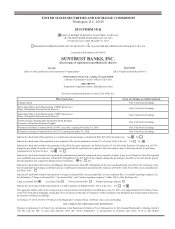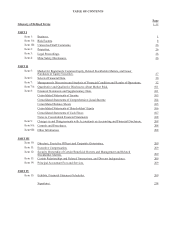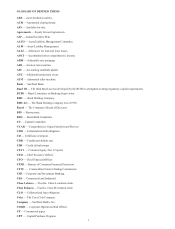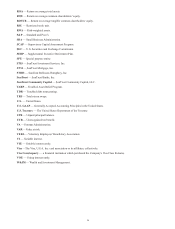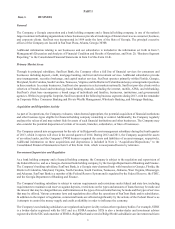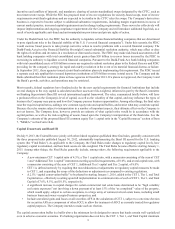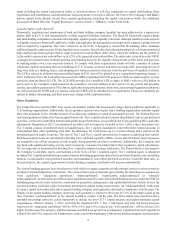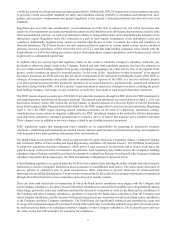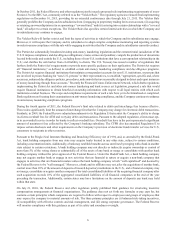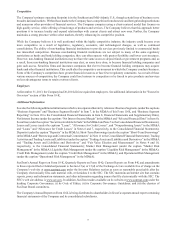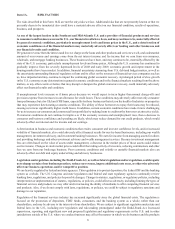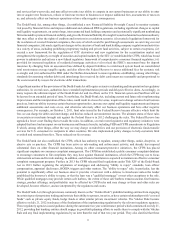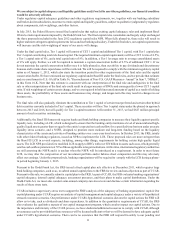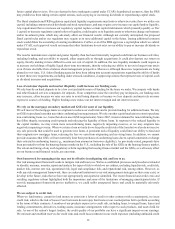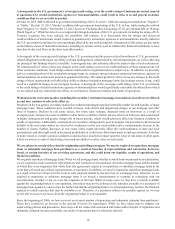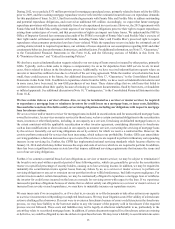SunTrust 2013 Annual Report Download - page 21
Download and view the complete annual report
Please find page 21 of the 2013 SunTrust annual report below. You can navigate through the pages in the report by either clicking on the pages listed below, or by using the keyword search tool below to find specific information within the annual report.5
would take priority over the parent's general unsecured creditors. Additionally, FDICIA requires the various regulatory agencies
to prescribe certain non-capital standards for safety and soundness relating generally to operations and management, asset
quality, and executive compensation and permits regulatory action against a financial institution that does not meet such
standards.
Regulators also must take into consideration: (i) concentrations of credit risk; (ii) interest rate risk (when the interest rate
sensitivity of an institution's assets does not match the sensitivity of its liabilities or its off-balance sheet position); and (iii) risks
from non-traditional activities, as well as an institution's ability to manage those risks, when determining the adequacy of an
institution's capital. Regulators make this evaluation as a part of their regular examination of the institution's safety and
soundness. Additionally, regulators may choose to examine other factors in order to evaluate the safety and soundness of
financial institutions. The Federal Reserve recently announced that its approval of certain capital actions, such as dividend
increases and stock repurchase, will be tied to the level of CET 1, and that bank holding companies must consult with the
Federal Reserve's staff before taking any actions, such as stock repurchases, capital redemptions, or dividend increases, which
might result in a diminished capital base.
In addition, there are various legal and regulatory limits on the extent to which the Company's subsidiary bank may pay
dividends or otherwise supply funds to the Company. Federal and state bank regulatory agencies also have the authority to
prevent a bank or bank holding company from paying a dividend or engaging in any other activity that, in the opinion of the
agency, would constitute an unsafe or unsound practice. In the event of the “liquidation or other resolution” of an insured
depository institution, the FDIA provides that the claims of depositors of the institution (including the claims of the FDIC as
subrogee of insured depositors) and certain claims for administrative expenses of the FDIC as a receiver will have priority
over other general unsecured claims against the institution. If an insured depository institution fails, insured and uninsured
depositors, along with the FDIC, will have priority in payment ahead of unsecured, nondeposit creditors, including the parent
bank holding company, with respect to any extensions of credit they have made to such insured depository institution.
The FDIC insures deposit accounts up to $250,000. It provides this insurance through the DIF, which the FDIC maintains by
assessing depository institutions an insurance premium. The amount each institution was assessed prior to April 1, 2011 was
based upon statutory factors that include the average balance of insured deposits as well as the degree of risk the institution
poses to the insurance fund. Pursuant to the Dodd-Frank Act, the FDIC changed how it assesses insurance premiums. Beginning
April 1, 2011, the FDIC began assessing deposit insurance premiums on the basis of a depository institution's average
consolidated net assets and not its deposits. Additionally, the FDIC introduced changes to the method by which it determines
each depository institution's insurance premium rate to include a variety of factors that translate into a complex scorecard.
These changes were in addition to previous changes related to pre-funding insurance premiums.
FDIC regulations require that management report annually on its responsibility for preparing its institution's financial
statements, establishing and maintaining an internal control structure and procedures for financial reporting, and compliance
with designated laws and regulations concerning safety and soundness.
The Dodd-Frank Act created the CFPB, which is separated into five units: Research, Community Affairs, Complaint Tracking
and Collection, Office of Fair Lending and Equal Opportunity, and Office of Financial Literacy. The CFPB has broad power
to adopt new regulations to protect consumers, which power it may exercise at its discretion and so long as it advances the
general concept of the protection of consumers. In particular, such regulations may further restrict the Company's banking
subsidiary from collecting overdraft fees or limit the amount of overdraft fees that may be collected by the Company's banking
subsidiary beyond the limits imposed by the 2009 amendments to Regulation E discussed below.
Federal banking regulators, as required under the GLB Act, have adopted rules limiting the ability of banks and other financial
institutions to disclose nonpublic information about consumers to nonaffiliated third parties. The rules require disclosure of
privacy policies to consumers and, in some circumstances, allow consumers to prevent disclosure of certain personal
information to nonaffiliated third parties. The privacy provisions of the GLB Act affect how consumer information is transmitted
through diversified financial services companies and conveyed to outside vendors.
There are limits and restrictions on transactions in which the Bank and its subsidiaries may engage with the Company and
other Company subsidiaries. Sections 23A and 23B of the Federal Reserve Act and the Federal Reserve's Regulation W, among
other things, govern the terms and conditions and limit the amount of extensions of credit by the Bank and its subsidiaries to
the Company and other Company subsidiaries, purchases of assets by the Bank and its subsidiaries from the Company and
other Company subsidiaries, and the amount of collateral required to secure extensions of credit by the Bank and its subsidiaries
to the Company and other Company subsidiaries. The Dodd-Frank Act significantly enhanced and expanded the scope and
coverage of the limitations imposed by Sections 23A and 23B, in particular, by including within its scope derivative transactions
by and between the Bank or its subsidiaries and the Company or other Company subsidiaries. The Federal Reserve enforces
the terms of 23A and 23B and audits the enterprise for compliance.


